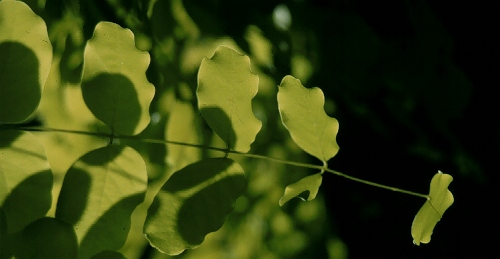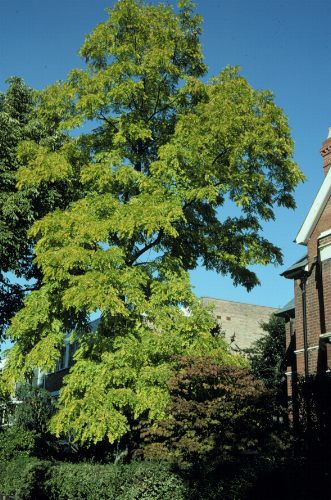Robinia pseudoacacia
Black Locust, Common Locust
Leguminosae
ExpandHabitat
- native to the central and southeastern United States
- hardy to zone 4
- Special Note: This species has demonstrated an invasive tendency in Connecticut, meaning it may escape from cultivation and naturalize in minimally managed areas. For more information, .
Habit and Form
- a medium-sized deciduous tree
- an upright tree with a somewhat narrow crown that is widest near the top
- branching is upright to irregular
- trunk is long and straight
- typically 40' to 50' tall but can be up to 70' tall
- many consider the branching to be unique and picturesque
Summer Foliage
- alternate, pinnately compound leaves
- leaves are 6" to 14" long
- leaves possess 7 to 19 leaflets
- leaflets are elliptic in shape
- color is a dark, dull, blue-green
Autumn Foliage
- unimpressive
- leaves drop a yellowish-green
Flowers
- pendulous clusters of pea-like flowers
- color is creamy white
- very fragrant
- flower clusters are 4" to 8" long
- blooms in late may to early June
- effective for a week or so
- relatively showy in bloom
Fruit
- a flat pod
- pods are 2" to 4" long
- matures in October and persists as dry brown fruits
Bark
- bark is a dark gray
- distinctive, heavy, rope-like ridges
- furrows interlace
Culture
- easily transplanted and grown
- full sun
- tolerant of most soils
- can perform well in dry, sterile sandy soils
- fixes nitrogen
- tolerant of salt, heat, pollution
- a very tough plant
- prune in late summer to avoid "bleeding"
Landscape Uses
- for difficult sites
- for shade
- erosion control
- for flowering effect
- revegetate strip mines
- use should be tempered in most residential landscapes
- wood is hard, making good fence posts
Liabilities
- a somewhat unkempt plant at times
- can spread by seed and root suckers
- locust borer
- leaf miner can totally disfigure plants by summer making them appear as through hit by a flame thrower
ID Features
- pinnately compound blue-green leaves
- narrow crown widest near the top
- white pendulous clusters of pea-like flowers; fragrant
- rope-like, thick, gray bark
- persistent flat brown pods
- stems glabrous with thorns around the buds on vigorous shoot
Propagation
- by seed
- by root cuttings
- by grafting
Cultivars/Varieties
'Frisia' - This plant has become very trendy and popular in the horticultural community. It is most notable for the foliage, which emerges golden yellow. This hue is held reasonably well throughout the season, but it does dull in warm summer areas such as New England. The spines on new shoots are colored red. It is a vigorous grower that may reach 30' to 50' tall. The plant may be employed to lighten up shaded areas.
'Idaho' (parentage uncertain, perhaps a selection of Robinia x ambigua) - A tough tree that tolerates difficult cultural conditions and the cold of USDA zone 3-4, this hybrid cultivar bears rosy-pink blooms in late spring. It grows to 40' tall with a spread of perhaps 30'.
'Purple Robe' (also listed as a selection of Robinia x ambigua and as 'Rouge Cascade') - A rose-pink flowering form, this selection forms a compact rounded 40' tree. The new growth emerges bronzy-red and retains some undertones of this color into summer. It may form fewer seeds than the species, plus it appears to flower slightly earlier in the season.
'Pyramidalis' (also known as 'Fastigiata') - Essentially spineless, this plant forms a strongly upright plant to 50' tall and perhaps 15' wide.
'Semperflorens' - This plant is notable for producing sporadic bloom after the initial late-spring flush.
'Tortuosa' and 'Lace Lady' (Twisty Baby™) - These selections form small trees with twisted, contorted branches and stems. They are often grafted and usually do not exceed 10' in height. Flowering is sparse or non-existent. Their artistic stems may lend interest to the winter garden.
'Umbraculifera' - A unique dwarf form, this plant only reaches 20' tall with a dense, umbrella-like canopy. It produces few or no thorns, but also flowers very sparsely. It appears prone to damage from ice and borer insects.

